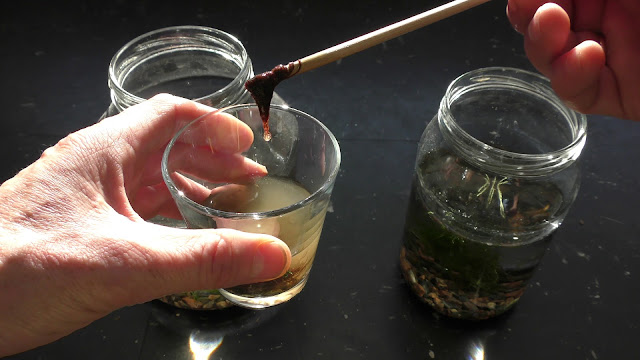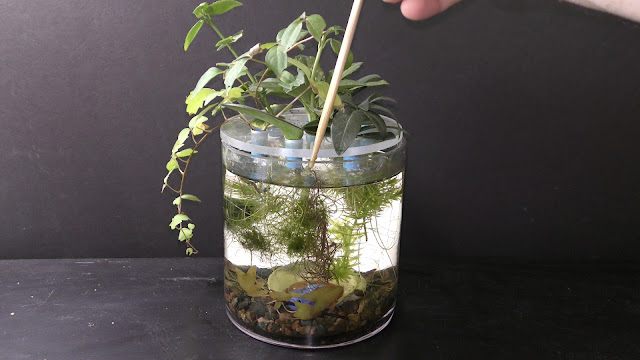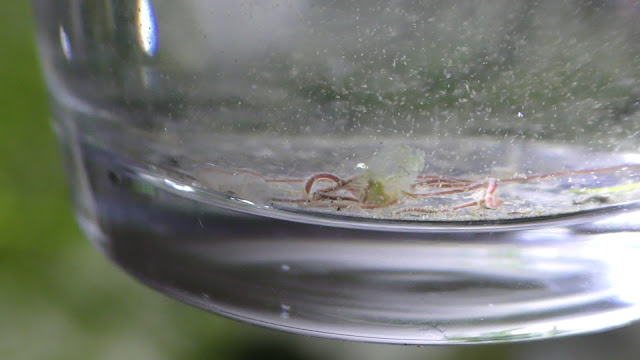I want to culture blackworms, also know as California blackworms, for feeding my fish in sustainable aquariums.
You can buy Blackworms on Amazon:
Use the jar lids to make planters as shown in previous videos.
First, let's add gravel to cover the bottom of the jars.
The small jar is about 1 liter capacity.
And the large jar I use here is about 1.5 liter.
Add dechlorinated tap water.
Now let's add plants.
Here I add a cutting of fast growing guppy grass in each tank.
Add any available plants.
Here I add growing underwater land moss.
Cover the jars with planters to reduce water evaporation and let them sit.
The package with blackworms arrived a couple weeks later on January 7th, 2021.
It is the second package I ordered.
The first packaged arrived with dead worms due to shipping delays.
For that reason, I prefer to buy any living things from local suppliers.
Okay... this time blackworms seem to be alive!
First, I empty the bag with blackworms into a clear glass cup.
Here you can see a single blackworm.
Which is more reddish than black to me :)
The water in the package is dirty.
Let's move blackworms without this water into the two prepared aquariums.
The blackworms sink down to the bottom.
I put some Bladder and Ramshorn snails in all my aquariums.
Blackworms at the bottom of the tank don't rush to spread out or hide in gravel.
Worms that got stuck on the plants slowly move down to the bottom.
For the first time, I feed them with a piece of dry mulberry leaf - just to check if they may like it.
It takes time for the leaf to sink down.
Cover the tank with the planter.
Initially, I decided to keep the water level to about half of the jar to imitate conditions blackworms live in Nature.
I put a bunch of blackworms in the 1.5 liter aquarium.
Also, feed them a piece of dry mulberry leaf.
So, that is how I set up two dedicated tanks with blackworms.
Now, let's add some blackworms right away into a well established sustainable aquarium with snails.
This is about 2 year old aquarium...looking good!
There are more blackworms left to house...
So, let's put them into this pair of 3 liter sustainable aquariums.
I had wild Minnows and dwarf guppies in these aquariums in the past.
There is no fish presently...only snails and some other tiny critters.
I reserve these two aquariums for an emergency or for housing new fish I may get anytime.
Blackworms may find here remains of fish food and such.
Blackworms clung together in clusters when I dropped them into all aquariums.
Eventually they spread around more or less evenly all around the bottom of the tank.
That is how blackworms look when nothing disturbs them.
You can see blackworms tails protrude above the gravel.
Blackworms hide in the gravel instantly sensing any danger.
For example, I tap on the glass...and blackworms disappeared!
Here you can see them coming out shortly after.
Blackworms hide from bright light and from any approaching shadow.
Here you can see blackworms hide away from the bright light of my camera.
Blackworms don't hide from scuds or snails and such.
It looks like a living carpet when there are many blackworms in the aquarium :)
In the following weeks, I start moving small batches of blackworms into aquariums with fish.
I add a half dozen blackworms at a time right after a regular feeding of my dwarf guppies.
Hungry fish may go after anything dropped into the aquarium.
I want blackworms to get safely to the bottom first.
Blackworms have better chances to survive hiding in the gravel.
Here they will feed on leftovers of fish food and other organic waste helping to keep my aquariums clean.
Eventually, I got blackworms in all my aquariums with fish.
And as the colony of blackworms grows in each aquarium, fish find and eat them.
I feed blackworms 3 times a week with the same homemade fish food I use to feed my fish.
These food flakes are made of plants and critters growing in the same aquariums.
All my aquariums are sustainable.
I don't use man-made filters, air pumps, and I don't change water.
It all works great for culturing blackworms.
And it makes blackworms a desirable addition in sustainable aquariums with fish.
Have fun and happy aquarium gardens :)







































































No comments:
Post a Comment